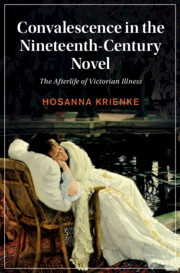Book contents
- Convalescence in the Nineteenth-Century Novel
- Cambridge Studies in Nineteenth-Century Literature and Culture
- Convalescence in the Nineteenth-Century Novel
- Copyright page
- Dedication
- Contents
- Acknowledgments
- Introduction Convalescent Time
- Chapter 1 Convalescence and the Working Class
- Chapter 2 Spiritual Convalescence
- Chapter 3 Novel Reading as Convalescence
- Chapter 4 Convalescence and Mental Illness
- Chapter 5 Imperial Convalescence
- Conclusion Convalescent Futures
- Notes
- Bibliography
- Index
- Cambridge Studies in Nineteenth-Century Literature and Culture
Chapter 3 - Novel Reading as Convalescence
Gender and Leisure in Wilkie Collins’s The Moonstone
Published online by Cambridge University Press: 24 May 2021
- Convalescence in the Nineteenth-Century Novel
- Cambridge Studies in Nineteenth-Century Literature and Culture
- Convalescence in the Nineteenth-Century Novel
- Copyright page
- Dedication
- Contents
- Acknowledgments
- Introduction Convalescent Time
- Chapter 1 Convalescence and the Working Class
- Chapter 2 Spiritual Convalescence
- Chapter 3 Novel Reading as Convalescence
- Chapter 4 Convalescence and Mental Illness
- Chapter 5 Imperial Convalescence
- Conclusion Convalescent Futures
- Notes
- Bibliography
- Index
- Cambridge Studies in Nineteenth-Century Literature and Culture
Summary
In Wilkie Collins’s The Moonstone (1868), Gabriel Betteredge recovers from the stress of the plot by, ironically, reading a different kind of novel. Betteredge of course exists in a sensation novel, a genre that supposedly produced physical symptoms of agitation and restlessness in readers. His chosen novel, by contrast, is Robinson Crusoe, a text whose “wholesome application” apparently produces entirely different physiological effects. Betteredge testifies to the health-giving power of Robinson Crusoe as “the remedy which I have never yet found to fail me in cases of doubt and emergency” (26). In the evenings, when the suspense of his own sensationalist mystery threatens to agitate physical symptoms (a malady he names “detective-fever”) he turns to this book to recuperate (131, original emphasis). He reports: “In this anxious frame of mind, other men might have ended by working themselves up into a fever; I ended in a different way. I lit my pipe, and took a turn at Robinson Crusoe” (86, original emphasis). Scholars have thoroughly discussed the ways in which literary reviewers of the 1860s and 1870s fretted about the physical pangs and excitations of female (or at least feminized) reader of sensation fiction. However, in this chapter, I show how reviewers of this era also theorized an alternative practice of healthful novel-reading, appropriate for men, that was modeled on the increasingly prominent discourse of convalescence. While Betteredge’s claims of the rejuvenating benefits of Robinson Crusoe are humorous, they are not far afield from the claims some contemporary reviewers made about the necessity of men’s leisurely novel-reading in the hectic modern age. As one 1865 review, published in Fraser’s Magazine, declared: the “first function [of fiction] is to entertain us, to amuse us, to give us agreeable relaxation. Nor let such entertainment be counted a trivial gain. Our health and sanity depend on it.”
- Type
- Chapter
- Information
- Convalescence in the Nineteenth-Century NovelThe Afterlife of Victorian Illness, pp. 74 - 96Publisher: Cambridge University PressPrint publication year: 2021



